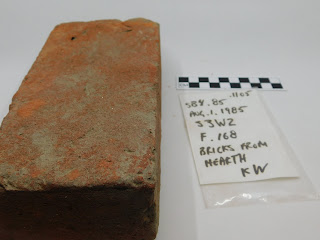Preservation Carpentry: How to Accurately Restore the Sherburne House at Strawbery Banke
Hi Everyone!
My name is Libby Ware and I am a rising senior at the University of Rhode Island majoring in Anthropology and Spanish and minoring in Political Science. For the 2022 Summer Field School, I chose to focus on preservation carpentry. Preservation carpentry is the craft of carpentry applied to historical buildings in preservation and restoration projects. The goal of preservation carpenters is to achieve historical accuracy in their craft.
In my study, I focused on the window lead cames, bricks, slate roofing, and window glass recovered at the Sherburne site during both the original excavation between 1977 and 1983 and later in 2019.
When looking at the bricks, the goal was to determine if the bricks recovered from Sherburne were produced at the nearby Toogood brick production site at Strawbery Banke, or put in later. The Toogood bricks were larger than the bricks recovered from Sherburne used at the time with their measurements being 8-9x4.25-4.5x2.25-2.5. This was one of the easier things to determine in my study as I measured the brick and it was the slightest bit smaller at 8x4x2.5. This leads me to believe that these bricks were installed in the 18th century when an addition was added.
The slate roofing was an area of interest as the current roof is asphalt. Slate lasts 125-200 years which makes it hard to date but we can still learn from it. According to CopperWorks' "The History of Slate Roofing," slate roofs did appear in the 1600s but the first quarry did not open until 1785, and slate was not mass quarried until the later part of the 19th century. At the site, a burnt slate was recovered indicating a possible fire. When looking at the Portsmouth Fire Department's Historical Records, I learned that there was an "incendiary fire [that] consumed entire contents of a barn owned by Samuel Sherburne at the Plains," on December 10th, 1804. While trying to figure out where this fire took place, I read an article from the time of the fire that was converted to an online article at Seacoast NH that described an arsonist, or as Brewster put it, an "incendiary," that set multiple fires in December of 1804. Although Samuel Sherburne is part of the same family as that of the Sherburne House, this fire took place at a farm they owned outside of town at the "Plains," and destroyed two barns, one containing valuables and another containing livestock.
Above are pictures of burnt slate recovered at Sherburne.
My main focus was the window lead and how to identify potential dates and/or names on the heart as seen on the Jamestowne Site. In order to be able to do this, I first had to soak the window lead in apple cider vinegar to loosen the rust that had built up over the years. Then I used a dental pick and tweezers to carefully unfurl the window lead. I did not uncover what I thought I was going to. Instead of a date or name, there were uniform lines inscribed on the heart.












Comments
Post a Comment